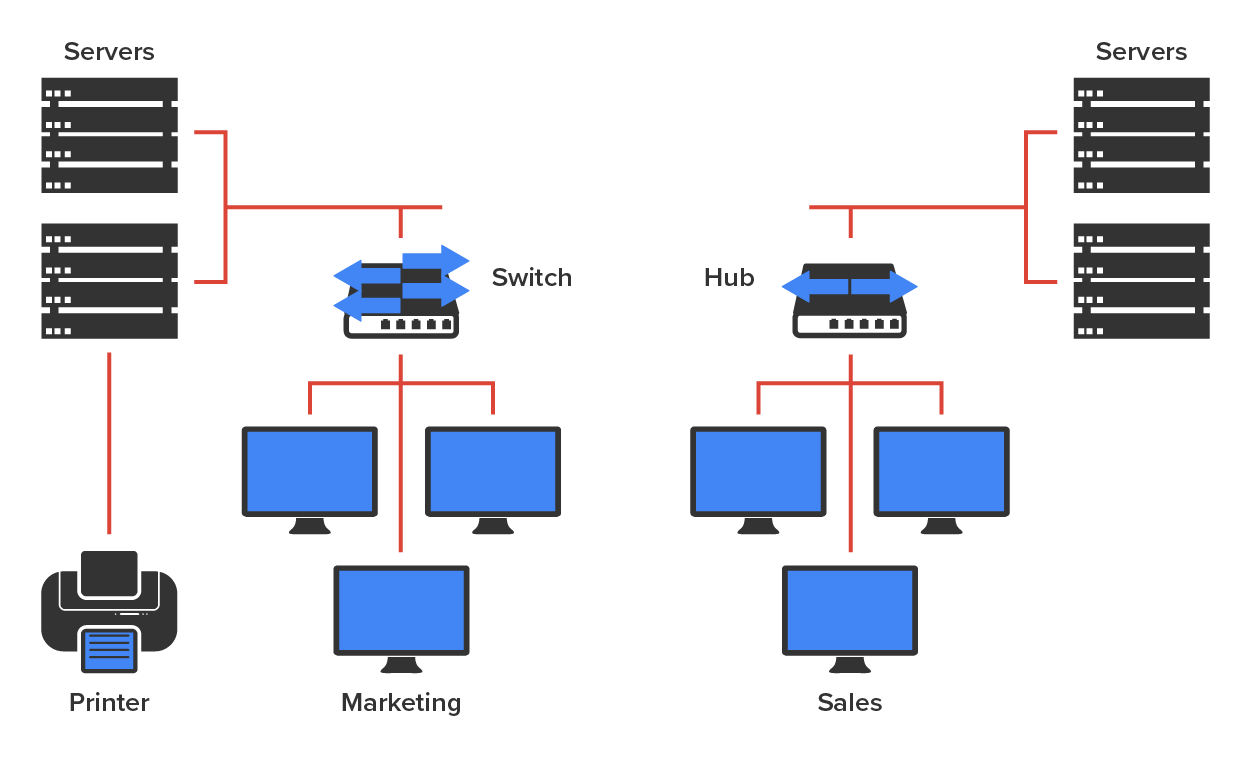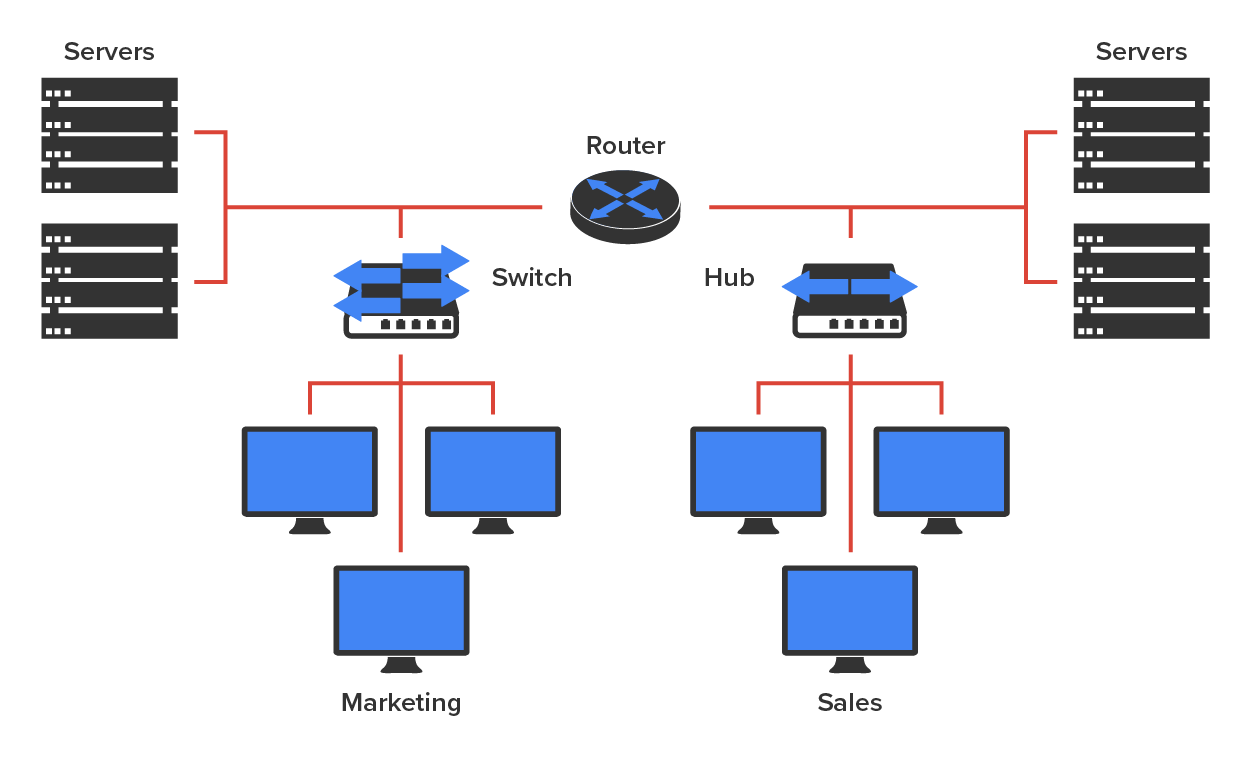Table of Contents |
A computer network is a system of computers and other digital devices connected to each other to share resources. Shared resources may include data, files, printers, network storage, access to the internet, and several other things. From a business perspective, the ability to share resources helps reduce cost and improve efficiency.
EXAMPLE
An office with 20 workers can share one networked printer rather than have 20 stand-alone printers attached as a peripheral device to each worker’s computer. A peripheral device is an electronic device that is outside the computer’s system unit (external to the computer’s enclosing case) but is used by the computer to which it is connected, such as a printer or a scanner.All types of digital devices can be attached to a network, including desktops, laptops, workstations, and smartphones. Any computer attached to a network can be called a host.
There are many types of networks. One of the distinguishing features of a network is the size of the geographic area that it covers. Another feature is whether the network is wired or wireless. Wired networks use various types of network cables to carry signals from device to device. Wireless networks use the radio frequency (RF) spectrum as a signal carrier.
A local area network (LAN) is usually restricted to a particular geographic location such as an office building, a single department within a corporate office, or even a small office or home office (SOHO).
EXAMPLE
You have most likely used a LAN if you have ever operated a computer or digital device at school or at work.An Ethernet LAN is wired and is built using various types of cables installed on a building’s premises. LANs typically have high bandwidth and low latency. A high bandwidth is good, because it means the network carries a large amount of data per second. A low latency is good, because there is very little delay. The most prominent LAN protocol is called Ethernet. We’ll learn more about how Ethernet works later in the course.

A wireless local area network (WLAN) is typically attached to a LAN to provide mobility to local users by way of an RF connection.
EXAMPLE
You have very likely used a WLAN if you have ever connected your smartphone or laptop to the wireless network in your home or workplace.The most prominent WLAN technology is called Wi-Fi. A WLAN infrastructure is built using various types of access points installed on a building’s premises. You will learn more about wireless networking in future tutorials.
A virtual local area network (VLAN) is a subnetwork of a LAN that enables specific groups of computers to communicate as if they were connected to the same network hardware.
EXAMPLE
VLANs are employed for computers or digital devices at an enterprise. You may have interacted with a VLAN at work or at school. It could have had more than 250 end users.VLANs will be discussed in more depth in future tutorials.
A wide area network (WAN) is another example of a network. A WAN is a computer network that covers a large geographic area, and it is scalable to a global level. For example, a large national corporation may have its headquarters in New York City and have regional offices in Minneapolis, Miami, and San Francisco. The WAN is the network that connects the LANs in the regional offices to each other. The WAN provides end users with access to resources located in remote offices. The internet is a worldwide WAN.
EXAMPLE
You have most likely used a WAN if you have ever accessed the internet.The following is a diagram of a WAN:

A personal area network (PAN) is a type of wireless computer network that covers a very small geographic area. This is typically an area of about 30 ft. A PAN uses Bluetooth, which is a wireless protocol.
A metropolitan area network (MAN) is a much larger network than a PAN. A MAN is a computer network that covers the area of a large city. This can include an area of up to a 25-mi radius.
EXAMPLE
You have very likely used a MAN if you have ever operated a computer or digital device at a workplace that has multiple office locations in the same city.Metropolitan area Ethernet (MAE) is a MAN service. MAEs are based on Ethernet standards. They can connect a customer to a larger network and the internet. If metro Ethernet is available, businesses can use it to connect their offices together. This setup presents another very cost-effective connection option. Some metro Ethernets use multiprotocol label switching (MPLS) networks in the internet service provider (ISP). They do this by providing Ethernet or a fiber-optic cable to the customer as a connection.
Another regionally based LAN is the campus area network (CAN). This is a network that encompasses several buildings. Although a LAN is typically confined to a single building, it provides data, services, and connectivity to the outside world to those who work in a corporate office or headquarters.
EXAMPLE
You have very likely used a CAN if you have ever operated a computer or digital device on a college or corporate campus.The final network in this tutorial is the storage area network (SAN). This network is composed of high-capacity storage devices that are connected by a high-speed private network (separate from the LAN) using a storage-specific switch. This storage information architecture facilitates the collection, management, and use of data. These networks are typically fiber-optic networks.
EXAMPLE
You have most likely used a SAN if you have ever operated a computer or digital device to save a file to the network of a large university or company.There are different ways to construct a network, just like there are different ways to build a house or an office building. You may already be familiar with the word “architecture” as it relates to building design. Similarly, the term network architecture simply means the structure and design of a network.
Computers connected to each other in a peer-to-peer network do not have a centralized controller; they are all peers, meaning that when it comes to authority, they are all equal. In a peer-to-peer network, there is no single machine that manages access to networked resources for all the other computers.
EXAMPLE
If you need to access a file on a peer-to-peer LAN as seen below, no extra permission will be required. Peer-to-peer LANs are not usually used in large businesses today, because there is no management. These differ from client-server LANs, which do require management. We will discuss client-server LANs later in this tutorial.The graphic below shows a basic peer-to-peer network:

A client-server network is a network in which a server provides controlled access to networked resources in response to client requests.
A client-server network is fundamentally different from a peer-to-peer network, since clients request resources from servers, which control access to shared resources.
EXAMPLE
A client sends a request to a server for a resource such as a website or access to a file.This architecture is primarily used in large businesses today because of the privacy and security concerns that these server-controlled systems can handle.
The graphic below shows a basic client-server network.

Source: This content and supplemental material has been adapted from CompTIA Network+ Study Guide: Exam N10-007, 4th Edition. Source Lammle: CompTIA Network+ Study Guide: Exam N10-007, 4th Edition - Instructor Companion Site (wiley.com)